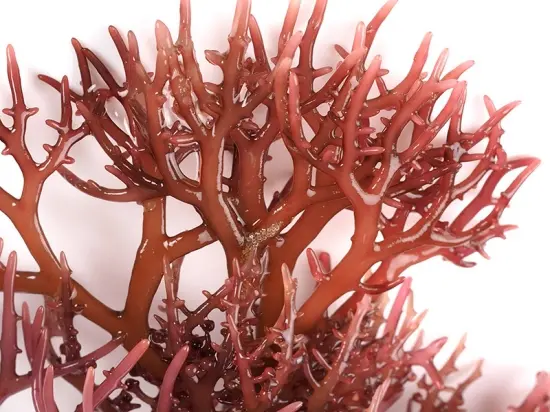
Gigartina pistillata
- Minerals
- Gelling Agent
- Iodine
On Demand weeks


DE-ÖKO-070
EU agriculture
Introduction: Gigartina pistillata
What is Gigartina pistillata?
Gigartina pistillata is a species of red algae, also known as a seaweed. It is commonly referred to as the frilly pink seaweed or the frilled red seaweed, and is highly valued for its potential uses in biotechnology, medicine, and food.
Gigartina pistillata is ecologically important as it provides habitat and food for a variety of marine animals, including invertebrates and fish. However, like many other seaweed species, it is susceptible to environmental stressors, such as pollution and climate change, which can have negative impacts on its growth and survival.
Where does Gigartina pistillata grow?
Gigartina pistillata is found in the eastern Pacific Ocean, ranging from California to Peru. Specifically, it can be found along the coast of North, Central, and South America, as well as the Galapagos Islands.
This species of red algae grows in the intertidal and subtidal zones, where it attaches to rocky surfaces and can form large patches or mats. It typically prefers areas with moderate to high wave action and high light intensity, and can be found in water depths ranging from the intertidal zone to about 30 meters deep.
Gigartina pistillata is commonly found in colder waters, such as those influenced by the California Current. However, it can also occur in warmer waters, such as in the Gulf of California.
For which application is Gigartina pistillata being used for?
Gigartina pistillata is being studied and used for a variety of applications, including biotechnology, medicine, and food.
In biotechnology, the species is valued for its high content of sulfated polysaccharides, which have antiviral, anticoagulant, and immunomodulatory properties[3, 4, 5].
In medicine, Gigartina pistillata is being investigated for its potential use in wound healing and tissue regeneration[7, 8].
In the food industry, Gigartina pistillata is used as a source of carrageenan, a gelling agent and thickener that is commonly used in a range of processed foods, such as ice cream, pudding, and deli meats. Carrageenan extracted from Gigartina pistillata is considered to be of high quality and has a more consistent gel strength than carrageenan obtained from other red algae species.
Overall, Gigartina pistillata is a valuable natural resource with a range of potential applications, and ongoing research is helping to uncover new ways in which this species can be utilized.
Typical applications: Gigartina pistillata
Typical applications
The macroalga Gigartina pistillata belongs to the red algae and is found among others on the Atlantic coasts of Europe, but its habitat goes far beyond that.
As it is a fresh product, Gigartina pistillata is well suited as an ingredient for fresh products and food. Due to its red color, it can enhance the food visually in addition to its taste and texture. Gigartina pistillata also has gelling properties which can benefit recipes.
This product is available in the following forms: Gigartina pistillata raw seaweed. This product is also available as a non-bio variant.
Sources:
- Gigartina pistillata - M.D. Guiry in Guiry, M.D. & Guiry, G.M. 06 February 2017. AlgaeBase. World-wide electronic publication, National University of Ireland, Galway. (https://www.algaebase.org/search/species/detail/?species_id=417)
- Gigartina pistillata - Wikispecies (https://species.wikimedia.org/wiki/Gigartina_pistillata)
- Pangestuti R, Kim SK. Biological activities of carrageenan. Adv Food Nutr Res. 2014;72:113-124. doi: 10.1016/B978-0-12-800269-8.00007-5. PMID: 25081080. (https://pubmed.ncbi.nlm.nih.gov/25081080/)
- Frediansyah A. The antiviral activity of iota-, kappa-, and lambda-carrageenan against COVID-19: A critical review. Clin Epidemiol Glob Health. 2021 Oct-Dec;12:100826. doi: 10.1016/j.cegh.2021.100826. Epub 2021 Jun 29. PMID: 34222718; PMCID: PMC8240443. (https://pubmed.ncbi.nlm.nih.gov/34222718/)
- Levy-Ontman O, Abu-Galiyun E, Huleihel M. Studying the Relationship between the Antiviral Activity and the Structure of ἰ-Carrageenan Using Ultrasonication. Int J Mol Sci. 2023 Sep 17;24(18):14200. doi: 10.3390/ijms241814200. PMID: 37762503; PMCID: PMC10531741. (https://pubmed.ncbi.nlm.nih.gov/37762503/)
- Cotas J, Marques V, Afonso MB, Rodrigues CMP, Pereira L. Antitumour Potential of Gigartina pistillata Carrageenans against Colorectal Cancer Stem Cell-Enriched Tumourspheres. Mar Drugs. 2020 Jan 12;18(1):50. doi: 10.3390/md18010050. PMID: 31940929; PMCID: PMC7024308. (https://pubmed.ncbi.nlm.nih.gov/31940929/)
- Neamtu B, Barbu A, Negrea MO, Berghea-Neamțu CȘ, Popescu D, Zăhan M, Mireșan V. Carrageenan-Based Compounds as Wound Healing Materials. Int J Mol Sci. 2022 Aug 14;23(16):9117. doi: 10.3390/ijms23169117. PMID: 36012381; PMCID: PMC9409225. (https://pubmed.ncbi.nlm.nih.gov/36012381/)
- Haroon B, Sohail M, Minhas MU, Mahmood A, Hussain Z, Ahmed Shah S, Khan S, Abbasi M, Kashif MUR. Nano-residronate loaded κ-carrageenan-based injectable hydrogels for bone tissue regeneration. Int J Biol Macromol. 2023 Nov 1;251:126380. doi: 10.1016/j.ijbiomac.2023.126380. Epub 2023 Aug 16. PMID: 37595715. (https://pubmed.ncbi.nlm.nih.gov/37595715/)

ALGANEX certificate system
Reply within twelve hours